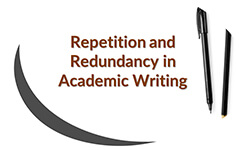
Repetition and redundancy are the primary barriers to successful writing. Words that appear many times in a single sentence may be tautologies or similar expressions used in various contexts. Paragraphs that are not essential sometimes include needless concepts or confusing descriptions, which is why redundancy may be a sign of repetition. Learn how to properly structure your academic writing by reading this article.
Definition: Repetition and redundancy
Redundancy is when a term or concept is used more than once without introducing anything to the previous. The redundant language echoes what has previously been stated, but it does not contribute anything to the discussion.
Repetition is a literary method where you use the same word or phrase several times, which is common in written works. Isocolon, anaphora, and epistrophe are only a few examples of effective repetition. Your work will be less concise if you use unnecessary terms. They are a source of confusion and distraction for the reader. Excessive words and details only extend your work without improving it.
in Your Thesis
Repetition and redundancy: Always enemies?
In addition to causing overall document difficulties, repetition and redundancy in individual phrases may also be problematic. It must be emphasized that repetition is not necessarily a bad thing. Using repetition may aid your readers’ comprehension. However, before using any recurring parts in your work, make sure you consider whether they are essential.
Repeating important concepts, particularly in lengthy papers covering difficult topics, can aid readers in keeping up with their repetition and redundancy levels. Some situations in which repetition is appropriate are presented below.
- Conclusions that restate the research question will refresh the reader’s memory and prove that the report accomplished its stated objective.
- Reference to your primary factors or topics: Instead of using various terms to relate to these main parts of the work, it is preferable to utilize a consistent vocabulary throughout the essay.
Paragraph and phrase constructions repeated with minor variations may provide a rhetorical flare and draw attention to key themes when utilized carefully.
How to avoid repetition and redundancy
One of the essential aspects you can do to ensure your work is original, is to not duplicate any phrases or paragraphs. In general, readers find repetition and redundancy annoying.
Do not duplicate headings
For the sake of those who are just interested in skimming the content, each part should have its header. If you find yourself with two distinct summaries, consider giving each one a more specific title.
Do not restate points
Finding a happy medium between restating key points to aid comprehension and boring or losing readers through excessive repetition is crucial in avoiding repetition and redundancy. In the results chapter, for example, you probably will not need to describe your techniques again if you have already done so in the approach section.
You may add brief asides to your paper that direct readers to the appropriate portion when you are worried that they will require more reminders.
- ✓ Free express delivery
- ✓ Individual embossing
- ✓ Selection of high-quality bindings
Repetition and redundancy: Finding the balance
Do’s
It is essential to find the sweet spot between restating key points to help readers keep up and avoiding needless repetition and redundancy that can distract or bore them. If you have previously described your approaches in the methodology chapter, you probably will not need to do it again in the outcomes chapter.
The insertion of brief asides that direct the reader to the appropriate area of the work is a good idea if you think your readers may require more reminders.
FAQs
Here are the best ways to avoid repetition and redundancy in your academic writing:
- Try out various transitional phrases.
- Change up your sentence length and structure.
- Avoid referring to many antecedents with the same pronoun.
The use of redundant language occurs when more words or phrases than required are used to describe the same idea.
Writing that is both simple and concise has no place for redundancy. The inability to write coherently and clearly will prevent you from producing useful technical reports.
Writers use repetition to create rhythm in their work. Repetition, like other aural acrobatics like rhyme, consonance, and assonance, makes a text more melodic.
